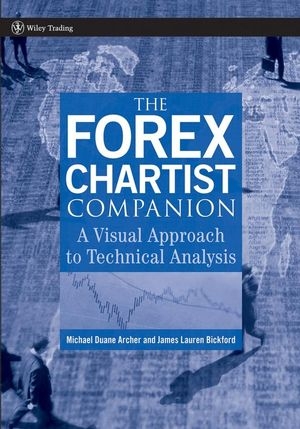
The Forex Chartist Companion
John Wiley & Sons Inc (Verlag)
978-0-470-07393-3 (ISBN)
THE FOREX CHARTIST COMPANION The foreign exchange (Forex) market has quickly become the market of choice for traders looking to increase their profit potential. The combination of high liquidity and low transaction costs-as well as twenty-four-hour accessibility-has attracted the attention of both new and veteran traders.
In The Forex Chartist Companion, authors and active Forex traders Michael Archer and James Bickford provide a visual window into the behavior of the Forex market along with detailed information on the mechanics of day trading, market entry timing, and much more. With this book as your guide, you'll not only become familiar with innovative software and charting systems that provide a graphical interpretation of the markets, but you'll also discover how to instantly see patterns throughout those markets.
Divided into six comprehensive parts, The Forex Chartist Companion:
Details Forex-specific charting techniques
Illustrates the use of point and figure charting in conjunction with Forex trading
Explores Forex swing charting
Outlines a variety of Western and Japanese reversal charts-from pivot charts to Kagi charts
Examines the actual trading system of veteran futures guru Charles Goodman
Filled with numerous charts-annotated with Archer's insight into the material-and in-depth information regarding charting theory, The Forex Chartist Companion will help serious traders use technical indicators to enter this market with confidence and exit with profits.
MICHAEL DUANE ARCHER has been an active commodity futures and Forex trader for over thirty years. He has worked in various advisory capacities, notably as a commodity trading advisor and a SEC-registered investment advisor. Archer operates www.fxpraxis.com and is a professional Forex money manager. He is also the author of Getting Started in Currency Trading, which is also published by Wiley. JAMES LAUREN BICKFORD began trading in commodity futures in the early 1980s. Since 2001, he has focused his investment efforts solely on trading spot currency pairs via online Forex dealers. Bickford's academic background is in computer science, mathematics, and statistics. By profession, he has been a software engineer for nearly three decades.
Acknowledgments xv
Introduction xvii
PART I Forex-Specific Charting Techniques 1
CHAPTER 1 Streaming Data 3
Overview 3
Tick Chart 3
Spread Chart 4
Conclusion 5
CHAPTER 2 Activity 6
Overview 6
Activity Bar Chart 6
Composite Activity 8
Time of Day Activity Chart 8
Day of Week Activity Chart 9
Equi-Activity Chart 10
Activity Mercury Chart 10
Uptick-Downtick Mercury Chart 12
Conclusion 13
CHAPTER 3 Direction 14
Overview 14
Direction Chart 14
Direction Mercury Chart 16
Activity-Direction Mercury Chart 17
Conclusion 18
CHAPTER 4 Forex versus Futures 19
Overview 19
Pip Differential Chart 19
Activity versus Volume and Open Interest 22
Conclusion 22
CHAPTER 5 Arbitrage 23
Overview 23
Transitivity 23
Triangular Arbitrage Chart 24
Equilibrium 25
Major Currencies 28
Observation 28
CHAPTER 6 The Mundo 29
Overview 29
Forex Beta 29
Mundo Line Chart 31
Weighting 32
Mundo Bar Chart 33
Observation 33
CHAPTER 7 Range Charts 34
Overview 34
Range Bar Chart 34
Composite Range Charts 35
Time of Day Range Chart 35
Day of Week Range Chart 37
Average Interval Range Chart 37
Observations 38
CHAPTER 8 Absolute Momentum 39
Overview 39
Absolute Momentum 39
Time of Day Momentum Chart 40
Day of Week Momentum Chart 41
Conclusion 42
CHAPTER 9 Two-Dimensional Momentum 43
Overview 43
Two-Dimensional Momentum Chart 43
Islands 45
Smoothing 47
Observation 47
CHAPTER 10 Moving Trend Analysis 49
Overview 49
Linear Regression 49
Ordinary Least Squares Method 50
Coefficient of Correlation 51
Trend Oscillators 51
Moving Slope Oscillator 52
Moving Correlation Oscillator 52
Moving Trend Index 52
Observations 54
PART II Point and Figure Charting 55
CHAPTER 11 History of Point and Figure Charting 57
Overview 57
History 58
CHAPTER 12 The Point and Figure Algorithm 59
Overview 59
P&F Anatomy 59
Box Size 59
Reversal Amount 60
Unraveling Bar Quote Data 61
P&F Algorithm 61
Time Representation 62
CHAPTER 13 Trend Lines 63
Support and Resistance 63
Trend Lines 63
Buy Signals 65
Sell Signals 65
CHAPTER 14 Double Tops and Bottoms 67
Overview 67
Double Top Pattern 67
Double Bottom Pattern 68
Double Top Signals 68
Double Bottom Signals 70
False Signals 72
Signal Percentages 72
Observations 74
CHAPTER 15 Triple Tops and Bottoms 75
Overview 75
Triple Top Pattern 75
Triple Bottom Pattern 76
Triple Top Signals 76
Triple Bottom Signals 78
False Signals 79
Signal Percentages 79
Observations 81
CHAPTER 16 Triangles 82
Overview 82
Ascending Triangles 82
Descending Triangles 83
Symmetrical Triangles 83
Triangle Signals 84
Ascending and Descending Frequencies 84
Symmetrical Frequencies 87
Observation 87
CHAPTER 17 Pattern Frequencies 89
Overview 89
Box Size =One Pip 90
Box Size = Two Pips 92
Box Size = Three Pips 93
Inverse Patterns 94
Usage 94
CHAPTER 18 Breakout Analysis 96
Overview 96
Preceding Columns 97
Succeeding Columns 100
Observations 102
CHAPTER 19 Count Methods 104
Overview 104
Horizontal Count (Buy) 104
Horizontal Count (Sell) 106
Vertical Count (Buy) 107
Vertical Count (Sell) 108
Observations 109
CHAPTER 20 Plotting Point and Figure Charts in Real Time 110
Overview 110
Tools of the Trade 110
Trading Platform 110
Trading Goals 111
Starting the Process 111
Real-Time Example 111
Performance Evaluation 114
PART III Forex Swing Charting 115
CHAPTER 21 Fibonacci Primer 117
Overview 117
Fibonacci the Man 117
Fibonacci the Series 118
Fibonacci the Ratios 119
Fibonacci the Equations 120
Binet’s Formula 122
Interpretation 122
Resources 124
CHAPTER 22 Swing Charts 125
Overview 125
Definitions 125
Box Size 126
Reversal Amount 126
Swing Reversal Algorithm 127
Time Alignment 128
Practical Examples 129
Composite Swing Charts 132
Usage 132
CHAPTER 23 The Measured Move 134
Overview 134
Testing Approach 135
Cluster Charts 135
Average Retracement 137
Decile Divisions 139
Practical Examples 141
Conclusion 146
CHAPTER 24 The Fifty Percent Principle 147
Overview 147
Testing Approach 147
Initial Results 148
Increasing Tolerance 150
CHAPTER 25 Improving The Third Wave Forecast 152
Overview 152
Methodology 153
Multiple Regression 154
Quartiles 154
Practical Examples 157
Fifty Percent Principle 160
Fifty Percent Examples 160
CHAPTER 26 Forecasting The Fourth Wave 162
Overview 162
Testing Approach 162
Practical Examples 164
Improving the Forecast 164
Three-Wave Trending Cycles 165
Trending Example 166
Three-Wave Nontrending Cycles 166
Nontrending Example 167
Extending the Forecast 167
Estimate Charts 168
Live Usage 170
CHAPTER 27 Cycle Frequencies 171
Overview 171
Two-Wave Cycles 171
Three-Wave Cycles 173
Four-Wave Bull Cycles 175
Four-Wave Bear Cycles 177
Usage 178
CHAPTER 28 Bull Cycles 180
Overview 180
Ideal Bull Cycle 180
Objective 181
Initial Results 182
Praxis 183
Caveat 185
Further Studies 185
CHAPTER 29 Bear Cycles 186
Overview 186
Ideal Bear Cycle 186
Objective 187
Initial Results 187
Praxis 188
Caveat 190
CHAPTER 30 Swing Properties 191
Overview 191
Wave Anatomy 191
Simple Ratios 192
Swing Averages 192
Swing Data Preliminaries 194
Bivariate Data 195
Swing Volatility 197
Swing Velocity 199
CHAPTER 31 Swing Summary 200
Overview 200
Selecting Swing Parameters 200
Composite Average Estimates 202
Caveat 207
PART IV Other Reversal Charts 209
CHAPTER 32 Western Reversal Charts 211
Overview 211
Geometric Chart 211
Trend Outline Chart 213
Pivot Chart 215
Observation 216
CHAPTER 33 Japanese Reversal Charts 217
Overview 217
Renko Chart 217
Kagi Chart 220
Three-Line Break Chart 224
PART V Goodman Swing Count System 227
CHAPTER 34 History 229
Charles B. Goodman 229
The Right Brackets 230
Later Developments 230
CHAPTER 35 Ordinal Principles 233
Ordinal versus Cardinal 233
The Measured Move 233
Congestion Phase 234
Equilibrium of Buyers and Sellers 235
CHAPTER 36 Cardinal Principles 238
Overview 238
Price Surge 238
Multilevel Matrices 239
Compensation 241
Carryover 241
Cancellation 242
Intersections 244
Five Points of a Goodman Wave 245
Double and Triple Intersections 246
CHAPTER 37 Goodman versus Elliott 247
Overview 247
Propagation 248
The Return 249
CHAPTER 38 Charting Study 251
Overview 251
Notation 251
Matrix 251
Propagation 253
Simple/Complex 254
Fat/Thin 255
Goodman and Computers 255
APPENDIXES
A.World Currencies 259
B. Exchange Rates 264
C. Euro Currency 267
D. Global Banking Hours 269
E. Monthly OHLC and Activity Charts 271
F. Daily OHLC and Activity Charts 282
G. Time of Day Charts (Activity) 293
H. Time of Day Charts (Range) 297
I. Time of Day Charts (Momentum) 301
J . Day of Week Charts (Activity) 305
K. Day of Week Charts (Range) 311
L. Day of Week Charts (Momentum) 317
M. Comparative Statistics 323
N. Unraveling Bar Quotes 325
O. Visual Basic Source Code (Point and Figure) 331
P. Visual Basic Source Code (Swing) 338
Resources 341
Index 349
About the Authors 361
| Erscheint lt. Verlag | 20.2.2007 |
|---|---|
| Reihe/Serie | Wiley Trading Series |
| Zusatzinfo | Charts: 305 B&W, 0 Color; Tables: 26 B&W, 0 Color |
| Verlagsort | New York |
| Sprache | englisch |
| Maße | 180 x 254 mm |
| Gewicht | 653 g |
| Themenwelt | Wirtschaft ► Betriebswirtschaft / Management ► Finanzierung |
| Wirtschaft ► Volkswirtschaftslehre ► Finanzwissenschaft | |
| ISBN-10 | 0-470-07393-4 / 0470073934 |
| ISBN-13 | 978-0-470-07393-3 / 9780470073933 |
| Zustand | Neuware |
| Informationen gemäß Produktsicherheitsverordnung (GPSR) | |
| Haben Sie eine Frage zum Produkt? |
aus dem Bereich


